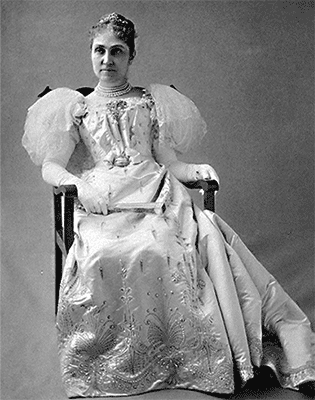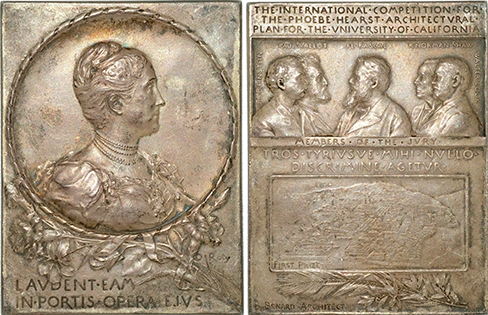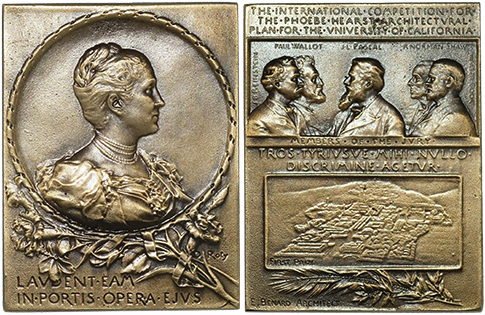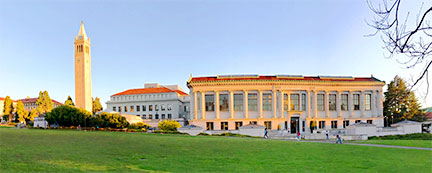2019 PCNS Papers
Table of ContentsRoma Pacifica
The Phoebe A. Hearst medal
by Michael F. Wehner
The University of California, with ten separate campuses and the management of three national laboratories, is the largest post-secondary academic and research institution in the world. Established in 1868 by the State Legislature, its origins trace back to the College of California, founded in 1855 in Oakland. The Berkeley campus was opened in September 1873 on the site of a farm in the foothills of the coastal range. Other campuses were either established or merged into the University over the course of the 19th and first half of the 20th century. However, until the 1950s with the establishment of a true university system, the President and Board of Regents, located in Berkeley, exercised tight control of all the campuses.
When George Hearst married the young schoolteacher Phoebe Apperson in 1862, he was already a successful and wealthy miner. Later a U.S. Senator, his large fortune was left to Phoebe upon his death in 1891. Mrs. Hearst focused much of her generous philanthropy on education. While not exclusively directed at the University of California, it is the Berkeley campus where her legacy is most apparent, with the Hearst name prominent throughout.

Mrs. Phoebe Apperson Hearst (UC Bancroft Library and Wikipedia). While the date of this photograph is unknown, the dress, necklace and tiara are similar to Roty’s medallic portrait, c.1899.
By the 1890s, the Regents ambitiously wished to expand the scope and reputation of the University and it was realized that the Victorian structures on campus did not encourage this ambition. Architectural instructor Bernard R. Maybeck began to investigate the development of a master plan to build a physical campus suitable for a great university. In 1896, at his encouragement, Mrs. Hearst proposed to the Regents that she would support an architectural contest at a level to encourage the best international designers to participate. A panel of international experts in design and architecture would judge “The International Competition for the Phoebe Hearst Architectural Plan for the University of California” with the following dispensation from the contest prospectus:
The purpose is to secure a plan to which all the buildings that may be needed by the University in its future growth, shall conform. All the buildings that have been constructed up to the present time are to be ignored, and the grounds are to be treated as a blank space, to be filled with a single beautiful and harmonious picture as a painter fills in his canvas.
The preliminary part of the contest, judged in Antwerp during fall 1898, drew one hundred and five entries from all over the world. As might have been intended, most of the twelve finalists, if not actually from the École nationale supérieure des beaux-arts in France, were heavily influenced by the then current Beaux Arts style. The final part of the contest was judged in San Francisco in September 1899, after at least eight of the finalists had visited the Berkeley site at Mrs. Hearst’s expense. The winner of the contest was declared to be Monsieur Émile Bénard of Paris who quickly came to California to claim his $10,000 prize and actually examine the planned location. To commemorate the successful completion of the architectural design contest, Mrs. Hearst commissioned the renowned French medalist, Oscar Roty, to create this silver plaquette medal.

The Silver Phoebe Hearst Medal (late 1899 or 1900)
- Obverse: (Encircled portrait bust of Phoebe A. Hearst with flowers below) / LAUDENT EAM / IN PORTIS OPERA EJUS / O ROTY
- Reverse: THE INTERNATIONAL COMPETITION FOR / THE PHOEBE HEARST ARCHITECTURAL / PLAN FOR THE UNIVERSITY OF CALIFORNIA / (busts of five men) / J. BREINSTEIN / PAUL WALLOT / JL PASCAL / R. NORMAN SHAW / WALTER COOK / MEMBERS OF THE JURY / TROS TYRIUSUE MIHI NUELO / DISCRIMINE AGETUR / (scene from the plan) / FIRST PRIZE / E BENARD ARCHITECT
- Bottom edge: (Cornucopia) ARGENT
- Dimensions: 0.834 fine silver 80x62mm
Perhaps because of the artist’s persona, the professional relationship between Benard and the University and even Mrs. Hearst herself was doomed from the start. By 1901, at Mrs. Hearst’s urging, the Regents hired the fourth place winner, John Galen Howard to develop a new plan based on Benard’s concepts. Supported financially by Mrs. Hearst, Howard founded the university’s architecture department. Not surprisingly, Howard’s interpretation of Benard’s plan eventually became his own and the current Berkeley campus bears little resemblance to Benard’s original drawings. University House, the Chancellor’s official residence, is the only building from Benard’s plan to actually have been built. Howard went on to design eighteen buildings and direct the design of other edifices by other campus architects. His notable structures include the Greek Theatre, the Sather Campanile, the Hearst Memorial Mining Building (in memory of George Hearst) and his masterpiece, the Doe Library. Following Mrs. Hearst’s death in 1919 and Howard’s retirement in 1927, her son, William Randolph Hearst, commissioned Bernard Maybeck and Julia Morgan to design several other campus buildings in honor of his mother.
That Phoebe Hearst would commission Oscar Roty to design her Beaux Arts medal was no coincidence. She was one of the wealthiest women in the western United States and conscious of her social standing as such. By 1899, Roty was likely the most famous of the contemporary French medalists and his medallic portrait of her was certainly a sign of perceived prestige and expense. The Latin phrase under her portrait on the obverse “Laudent eam in portis opera ejus” is a not so subtle reference to her philanthropy, translating as “Let them praise her in the gates because of her work”. The other Latin phrase on the reverse “Tros Tyriuse mihi nuelo discimine agetur” ensures that the contest would be fair as it translates to “Trojan and Tyrian will be treated by me with no distinction” and is a quote from Dido, queen of Carthage in Virgil’s epic poem, The Aeneid.
The rectangular format of the Phoebe Hearst medal is characteristic Roty. For it was twenty years earlier that Roty realized that rectangular plaquettes struck on both sides would be a popular and lucrative medallic variety. This design is one of many that he produced over the course of his long career.
The original silver version pictured is marked with the typical cornucopia mintmark and “ARGENT” indicating that it was struck at the Monnaie de Paris. This silver medal is very rare as I can only trace three examples in auction records plus two in the holdings of the Bancroft Library at the University of California Berkeley. It is unknown at this time how many were struck and to whom they were presented. It seems unlikely that such a private issue would have been offered for sale to the public.
Roty would have designed the medal in a larger format using a soft material. At least three bronze castings in larger formats exist. A uniface reverse casting (Baxter 38) of 140X108mm was donated by the collector and author Robert J. Eidlitz to the holdings of the American Numismatic Society in New York City. A uniface obverse casting of the same size was offered on ebay recently and a 137X103 two sided casting sold in the October 28, 2000 sale of the Presidential Coin and Antique Company for $600. That pattern has three differences from the medal as actually released in addition to the large size. First, to the left of Mrs. Hearst’s portrait is her name in three lines, MRS. / PHOEBE / A. HEARST . Second, FIRST PRIZE is misspelled as FIRST PRICE. Third, E. BERNARD ARCHITECT is spelled in French as E. BERNARD ARCHITECTE and is in a very sloppy font, as if it had been hastily added after the winner had just been announced.
In 1990, as part of the “Keeping the Promise” fundraising campaign of the University of California at Berkeley, the Hearst medal was reissued in an antique bronze-like fabric and given to supporters of the $470M campaign. The reissues are about 5% smaller on each side than the original silver medal at 76x59mm and came in a custom blue case with a logo on the front depicting the landmark Sather Campanile on campus. A printed insert tells “of a limited edition of 2300 which has been specially minted from the original”. The insert goes on to erroneously describe the original as “cast in silver”, when it was, of course, die struck by Monnaie de Paris. However, close examination of reissued medals reveals a high amount of surface porosity, suggesting that they were in fact cast rather than die struck. However, casting shrinkage of the metal itself would only be about 2% and does not account for all of the size difference between original and reissue. Hence, it is difficult to say for certain how the reissues were manufactured without documentary evidence.

The Phoebe Hearst Medal 1990 Reissue, same as the 1899 medal except 76x59mm, oxidized bronze, and no edge marking
Today’s campus of the University of California at Berkeley is a mix of architectural styles, ranging from the very modern to century old buildings in Howard’s interpretation of the Beaux Arts style, many of which are listed on the National Register of Historic Places. Capital fundraising appears to be a continuous activity as many of these older buildings are somewhat worse for wear. Additionally, seismic standards are much stricter today and retrofits of historic buildings are very expensive. Although most of Monsieur Benard’s winning master plan was never implemented, Phoebe Hearst’s architectural contest did result in a campus suitable for a world class university and her name is permanently associated with the University of California at Berkeley.
Sources
- Trustees of the Phoebe A. Hearst Architectural Plan for the University of California (1901), The International Competition for the Phoebe Hearst Architectural Plan for the University of California. H. S. Crocker Company.
- Robert James Eidlitz (1927): Medals and medallions relating to architects / compiled and edited and reproduced in great part from the collection of Robert James Eidlitz. New York, privately printed.
- Barbara A. Baxter (1987): The Beaux-Arts Medal in America. American Numismatic Society. New York.
- Presidential Coin and Antique Company (2000): Richard B. Dusterberg Collection of Official Presidential Inaugural Medals and Memorabilia auction catalog
- Robert Judson Clark (2001). Roma Pacifica: The Phoebe Hearst International Architectural Competition and the Berkeley Campus, 1896–1930. http://www.lib.berkeley.edu/uchistory/archives_exhibits/online_exhibits/romapac ifica/index.html
- Presidential Coin and Antique Company (2007): Auction Seventy-Seven catalog
- Helen Lovatt (2013) The eloquence of Dido: exploring speech and gender in Virgil’s Aeneid. Dictynna, Vol. 10. http://journals.openedition.org/dictynna/993
- David Hill (2014). Renaissance Man: The Work of Medal Innovator Louis-Oscar Roty in Drawings, Medals,and Letters at the ANS. American Numismatic Society Magazine: 2014, Issue 4
- Alexandra M. Nickliss (2018). Phoebe Apperson Hearst: A Life of Power and Politics. U. of Nebraska Press
- Newman Numismatic Portal. https://nnp.wustl.edu/
- Mintmarks and symbols on Monnaie de Paris medals. http://www.blog- simmonsgallery.co.uk/mint-marks-and-symbols-on-monnaie-de-paris-medals/

The Sather Campanile and Doe Library, designed by John Galen Howard